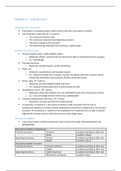Math 211, Multivariable Calculus, Fall 2011
Final Exam Solutions
1. (10 points) Find the equation of the plane that contains both the point (−1, 1, 2) and
the line given by
x = 1 − t, y = 1 + 2t, z = 2 − 3t.
Solutions: A point on the line is (1, 1, 2) and a vector parallel to the line is h−1, 2, −3i.
Another vector parallel to the plane we want is h2, 0, 0i (the vector between the two
points we have) so a vector perpendicular to the plane is given by
n = h2, 0, 0i × h−1, 2, −3i = h0, 6, 4i .
The equation of the plane is therefore
6(y − 1) + 4(z − 2) = 0
or
6y + 4z = 14 .
2. (10 points) Consider the function f (x, y) = x2 (y − 1).
(a) What is the directional derivative of f at (1, 3) in the direction of the vector
v = h3, −4i?
Solution: ∇f = h2x(y − 1), x2 i, so ∇f (1, 3) = h4, 1i. The directional derivatives
is therefore
h4, 1i · h3, −4i 8 8
=√ = .
| h3, −4i | 25 5
(b) What is the maximum directional derivative of f at (1, 3), and in which direction
does it occur?
Solution: The maximum directional derivative is the length of the gradient vector
√
17 and it is in the direction of the gradient vector h4, 1i .
3. (10 points) Find the linear approximation to the function f (x, y) = 2 − sin(−x − 3y)
at the point P = (0, π), and then use your answer to estimate f (0.001, π).
Solution: The linear approximation is given by
l(x, y) = f (0, π) + fx (0, π)(x − 0) + fy (0, π)(y − π).
We have fx = cos(−x − 3y), so fx (0, π) = cos(−3π) = −1 and fy = 3 cos(−x − 3y), so
fy (0, π) = 3 cos(−3π) = −3. Also f (0, π) = 2 − sin(−3π) = 2. Therefore
l(x, y) = 2 − (x − 0) − 3(y − π) .
So we have
f (0.001, π) ≈ 1.999 .
, 4. (5 points) Prove that, for any curve described by a vector-valued function r(t), the
unit tangent vector T(t) is always orthogonal to its derivative T0 (t).
Solution: The unit tangent vector is a unit vector so
T(t) · T(t) = 1.
Differentiating both sides we get
T0 (t) · T(t) + T(t) · T0 (t) = 0
so
T0 (t) · T(t) = 0.
Therefore T0 (t) is perpendicular to T(t).
5. (10 points) Let C be the curve given by
r(t) = (cos t + t sin t)i + (sin t − t cos t)j, for t > 0.
Find the unit tangent vector T(t), unit normal vector N(t), and curvature κ(t) for C.
(Your answers should be functions of t.)
Solution: We have
r0 (t) = ht cos t, t sin ti
so p √
|r0 (t)| = t2 cos2 t + t2 sin2 t = t2 = t
since t > 0. Therefore the unit tangent vector is
r0 (t)
T(t) = = hcos t, sin ti .
|r0 (t)|
Differentiating this we get
T0 (t) = h− sin t, cos ti .
Then
T0 (t) h− sin t, cos ti
N(t) = 0
= = h− sin t, cos ti .
|T (t)| 1
The curvature is then
|T0 (t)| 1
κ(t) = 0 = .
|r (t)| t
6. (5 points) Show that the function
2 2
x − y if (x, y) 6= (0, 0);
f (x, y) = x2 + y 2
0 if (x, y) = (0, 0);
is not continuous at (0, 0).
Final Exam Solutions
1. (10 points) Find the equation of the plane that contains both the point (−1, 1, 2) and
the line given by
x = 1 − t, y = 1 + 2t, z = 2 − 3t.
Solutions: A point on the line is (1, 1, 2) and a vector parallel to the line is h−1, 2, −3i.
Another vector parallel to the plane we want is h2, 0, 0i (the vector between the two
points we have) so a vector perpendicular to the plane is given by
n = h2, 0, 0i × h−1, 2, −3i = h0, 6, 4i .
The equation of the plane is therefore
6(y − 1) + 4(z − 2) = 0
or
6y + 4z = 14 .
2. (10 points) Consider the function f (x, y) = x2 (y − 1).
(a) What is the directional derivative of f at (1, 3) in the direction of the vector
v = h3, −4i?
Solution: ∇f = h2x(y − 1), x2 i, so ∇f (1, 3) = h4, 1i. The directional derivatives
is therefore
h4, 1i · h3, −4i 8 8
=√ = .
| h3, −4i | 25 5
(b) What is the maximum directional derivative of f at (1, 3), and in which direction
does it occur?
Solution: The maximum directional derivative is the length of the gradient vector
√
17 and it is in the direction of the gradient vector h4, 1i .
3. (10 points) Find the linear approximation to the function f (x, y) = 2 − sin(−x − 3y)
at the point P = (0, π), and then use your answer to estimate f (0.001, π).
Solution: The linear approximation is given by
l(x, y) = f (0, π) + fx (0, π)(x − 0) + fy (0, π)(y − π).
We have fx = cos(−x − 3y), so fx (0, π) = cos(−3π) = −1 and fy = 3 cos(−x − 3y), so
fy (0, π) = 3 cos(−3π) = −3. Also f (0, π) = 2 − sin(−3π) = 2. Therefore
l(x, y) = 2 − (x − 0) − 3(y − π) .
So we have
f (0.001, π) ≈ 1.999 .
, 4. (5 points) Prove that, for any curve described by a vector-valued function r(t), the
unit tangent vector T(t) is always orthogonal to its derivative T0 (t).
Solution: The unit tangent vector is a unit vector so
T(t) · T(t) = 1.
Differentiating both sides we get
T0 (t) · T(t) + T(t) · T0 (t) = 0
so
T0 (t) · T(t) = 0.
Therefore T0 (t) is perpendicular to T(t).
5. (10 points) Let C be the curve given by
r(t) = (cos t + t sin t)i + (sin t − t cos t)j, for t > 0.
Find the unit tangent vector T(t), unit normal vector N(t), and curvature κ(t) for C.
(Your answers should be functions of t.)
Solution: We have
r0 (t) = ht cos t, t sin ti
so p √
|r0 (t)| = t2 cos2 t + t2 sin2 t = t2 = t
since t > 0. Therefore the unit tangent vector is
r0 (t)
T(t) = = hcos t, sin ti .
|r0 (t)|
Differentiating this we get
T0 (t) = h− sin t, cos ti .
Then
T0 (t) h− sin t, cos ti
N(t) = 0
= = h− sin t, cos ti .
|T (t)| 1
The curvature is then
|T0 (t)| 1
κ(t) = 0 = .
|r (t)| t
6. (5 points) Show that the function
2 2
x − y if (x, y) 6= (0, 0);
f (x, y) = x2 + y 2
0 if (x, y) = (0, 0);
is not continuous at (0, 0).











